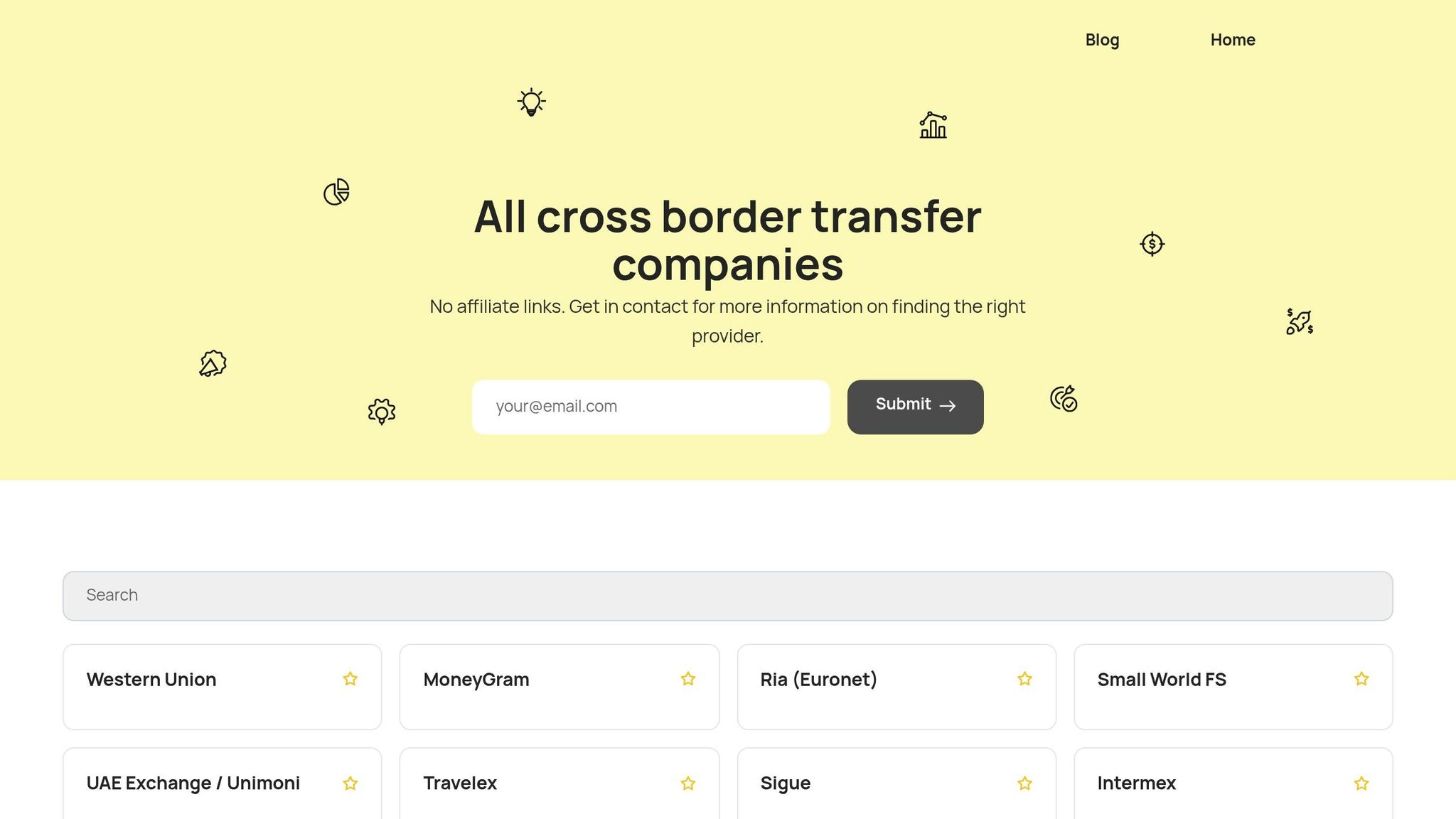When transferring money internationally, hidden fees and unclear exchange rates can eat into the amount your recipient gets. On average, global remittance fees are 6.65% for $200, but they can climb as high as 15–20% for less common routes.
To avoid surprises, remittance providers are required by U.S. law to clearly disclose:
- Transfer fees (including third-party fees and taxes).
- Exchange rates (with any markups explained).
- Final amount the recipient will receive in their local currency.
- Delivery times for the transfer.
Transparency isn’t just about avoiding fines - it builds trust with customers. For example, in February 2025, Wise was fined $2.5 million for failing to meet these standards, highlighting the importance of clear communication.
Here’s how you can ensure transparency in remittance pricing:
- Break down all fees (provider, taxes, third-party charges).
- Explain exchange rate markups clearly.
- Show the recipient’s final amount after deductions.
- Provide accurate delivery timelines.
Consumers also have rights, like canceling a transfer within 30 minutes or reporting errors within 180 days. Following these practices not only ensures compliance but also helps customers make informed decisions.
Want to compare providers? Tools like Cross Border Payments Companies offer detailed profiles, fee breakdowns, and user reviews to help you choose the best option for your needs.
Why Are International Money Transfer Fees From Asia Not Transparent? - Living in Asia as an American
Checklist for Clear Remittance Pricing
Transparent pricing isn’t just a regulatory requirement - it’s also key to earning customer trust. Here’s how you can ensure your remittance process is clear, compliant, and customer-friendly.
Disclose All Transaction Fees
- Break down provider fees and taxes in USD, clearly labeling them as "Transfer Fees" and "Transfer Taxes" before the transaction is finalized.
- Highlight any covered third-party fees in the recipient’s currency under "Other Fees."
- Add a disclaimer for non-covered third-party fees (like recipient bank wire fees) to warn customers about possible deductions from the final amount.
"Transparency is a cornerstone of Subpart B, mandated through specific disclosures provided to the sender at key points in the transaction."
– Elizabeth Crew, CRCM, CAMS, ABA Risk and Compliance
Provide Full Exchange Rate Details
- Clearly communicate exchange rate markups as additional costs. If your rate includes a markup, spell it out. For instance, one provider states:
"Our exchange rate includes a 3% markup charge. For more information, please click here". - Break down charges clearly, such as:
- "Variable fee 3%"
- "Total fees $3.00"
- "Conversion amount $97.00"
- "Exchange rate: 1 GBP = 1.30 USD".
- Avoid misleading claims like "zero fee" if exchange rate markups apply. Customers can feel misled if the absence of fixed fees is overshadowed by hidden rate markups. This is especially important since 44% of businesses express frustration with poor exchange rates.
State Recipient's Final Amount
- Show the exact amount the recipient will receive in their local currency, factoring in all deductions like provider fees, covered third-party fees, and exchange rate conversions.
- Provide a detailed breakdown starting from the sent USD amount to the final total in the recipient’s currency, using proper currency symbols for clarity.
Disclose Delivery Times
- Use specific timeframes in the MM/DD/YYYY and 12-hour clock formats. For example, "Funds typically arrive by 3:00 PM EST on 10/15/2025."
- Explain factors that might impact delivery times, such as correspondent bank processing, local banking hours, or regulatory reviews. If delivery times vary by the funding method, make these differences clear to customers.
Make Fee Information Easy to Find
- Display fee details prominently on your website and mobile app, ensuring customers don’t have to dig through excessive navigation or register for an account to find them.
- Maintain consistent terminology across all customer-facing materials, including marketing content, your website, and transaction confirmations.
- Offer fee calculators that provide real-time pricing based on variables like send amount, destination, and delivery method. These tools should include all fees and display both the USD cost and the recipient's final amount.
"The core pillars of compliance revolve around accurate definitions, meticulous disclosures (including the careful use of estimates), timely and correct error resolution, and proper handling of cancellations."
– Elizabeth Crew, CRCM, CAMS, ABA Risk and Compliance
Regulatory Requirements and Consumer Protections
In the U.S., regulations go hand-in-hand with transparent pricing practices, ensuring that consumers are protected through clear disclosures and well-defined rights when it comes to remittance transactions.
Key U.S. Regulatory Requirements
The Remittance Transfer Rule requires businesses handling over 500 transfers annually to be upfront about fees, exchange rates, and delivery times. This means they must provide written disclosures before a transaction is authorized, detailing the exact amount the recipient will receive and an estimated timeline for delivery.
To ensure compliance and safeguard consumers, the Consumer Financial Protection Bureau (CFPB) actively oversees and enforces these regulations. Their efforts push businesses to prioritize transparency and accountability, creating a more trustworthy remittance marketplace.
Consumer Rights and Protections
U.S. regulations don’t just focus on businesses - they also give consumers specific rights. For instance, customers have a 180-day window to report errors and can cancel a transaction within 30 minutes if the funds haven’t been received yet. These measures ensure that consumers have the tools to address issues promptly.
Additionally, providers are required to communicate all details - fees, exchange rates, and delivery timelines - in plain, straightforward language. This focus on clarity ensures that consumers fully understand the terms of their transactions, fostering trust and confidence.
"With recent enforcement actions, remittance providers must stay ahead of evolving requirements to avoid penalties and mitigate risks." – InnReg
These safeguards reinforce the importance of transparency in remittance services, providing a solid foundation for fair and reliable practices.
sbb-itb-165eed9
Common Pitfalls to Avoid
Avoiding common pitfalls is just as important as following best practices when it comes to transparent remittance pricing. Even well-meaning businesses can make mistakes that erode trust and lead to regulatory issues.
Hiding Third-Party Fees
One common misstep is failing to disclose all third-party fees, such as intermediary bank charges or recipient fees. Customers often assume the full amount they send will reach the recipient, so undisclosed fees can quickly damage trust. To prevent this, provide a detailed breakdown of all potential fees, including realistic ranges based on past data. Explain when and why these charges might apply.
Another area where transparency is often lacking is in exchange rate markups.
Not Clarifying Exchange Rate Markups
Exchange rate markups are a major, yet frequently misunderstood, cost in remittance services. Studies show that 44% of businesses are dissatisfied with unfavorable exchange rates when making international payments. Some providers advertise "no fees" but embed significant costs into their exchange rates. For example, traditional banks may apply markups exceeding 4% for certain currency pairs, while newer providers might offer lower markups ranging from 0.35% to 2%. Without clear explanations, customers are left in the dark about the true cost of their transactions.
"Where the consumer is not clearly informed that the firm's exchange rate differs from the reference rate, it may lead to misunderstandings about the actual cost. Some firms emphasise the absence of a fixed fee which can create the misleading impression that no costs apply to the remittance." – FCA
To address this, benchmark your rates against the mid-market rate and clearly display the markup percentage. For instance, if the mid-market rate for USD to EUR is 0.9200 and your rate is 0.9100, explain that this reflects a 1.09% markup. This level of transparency builds trust by helping customers understand the real cost of their transactions.
Failing to disclose such details can also expose businesses to regulatory risks.
Providing Incomplete or Misleading Information
Incomplete or misleading fee disclosures can harm customer relationships and invite regulatory penalties. Past enforcement actions have demonstrated the risks of failing to provide clear and accurate information.
Some common mistakes include advertising fee structures that don’t account for the total cost or promoting special offers without outlining the terms and conditions. To avoid these issues, ensure all customer communications are straightforward and honest. Display standard pricing prominently, clearly label promotional offers with their conditions, and make sure fee calculators reflect actual costs rather than idealized scenarios. When factors like delivery times depend on payment methods or destinations, provide clear ranges and explain what influences those variations.
"The consumer is clearly informed about the fee structure, ensuring transparency in pricing. Additionally, all fees are totalled to provide a clear and comprehensive view of the overall cost." – FCA
As regulatory oversight in the remittance industry increases, authorities are paying close attention to fee and exchange rate transparency. Non-compliance doesn’t just result in fines - it can also harm your reputation, drive away customers, and disrupt your long-term business operations.
Tools and Resources for Comparing Remittance Providers
Finding a remittance provider with straightforward pricing can feel like navigating a maze. Thankfully, specialized directories and comparison platforms simplify this process by offering detailed provider profiles, pricing breakdowns, and user reviews. These resources remove the guesswork, making it easier to evaluate providers and choose one that aligns with your needs. This section introduces tools that can help you compare fee structures and select the most suitable provider.
A striking statistic underscores the importance of choosing wisely: 48% of surveyed businesses report losing up to 10% of their international revenue due to limited payment options from vendors. This isn't just about transparency - it directly impacts your bottom line. To narrow down your options effectively, start by identifying your transaction volume, average transfer amounts, and commonly used currencies.
Features of Cross Border Payments Companies

Cross Border Payments Companies is a directory designed to simplify the often-confusing world of international money transfers. It provides in-depth profiles of major players like Western Union, MoneyGram, Ria, Revolut, and others, with a strong focus on clarity and practical usability.
What makes this directory particularly helpful is its structured approach to evaluating providers. Each profile includes details such as API availability, primary transfer corridors, and clear assessments of strengths and weaknesses. This makes it easier to spot which providers are upfront about their fees and which ones might have more complex pricing structures.
Beyond listing features, the directory dives into real-world use cases. Whether you're an individual sending money to family abroad or a business managing global payroll, the platform helps you find a provider that matches your transaction patterns and volume. It also bridges the gap by covering both personal transfers and business payment solutions, ensuring a comprehensive view of your options.
How to Use the Directory Effectively
Start by understanding your specific needs. Think about your transaction volume, average transfer size, and frequently used currencies. This will help you filter out providers that don't align with your goals and focus on those that do.
When reviewing providers, prioritize those that offer a complete breakdown of fees. Look for transparency in exchange rate markups, intermediary fees, and recipient charges. Providers that clearly outline these costs upfront are often the most reliable. As noted by Transfi, “Good exchange rates are key for lowering costs and boosting profits in cross-border transactions. Companies should find providers that offer friendly exchange rates and low margins to improve their foreign exchange services”.
Security and compliance are equally important. Use the directory to check for details on encryption, fraud detection, multi-factor authentication, and adherence to AML and KYC regulations. These factors are usually highlighted in the strengths and weaknesses sections of each provider profile.
For business users, API availability can be a game-changer. Providers with robust APIs often offer better integration options, automated reporting, and advanced transaction tracking - tools that not only enhance transparency but also help manage costs more effectively.
Finally, take advantage of user reviews and ratings. Real feedback often uncovers insights about hidden fees, customer service quality, and other factors that marketing materials might gloss over. Cross-referencing these reviews with the directory's profiles ensures a more informed decision.
Conclusion
Transparent remittance fees play a key role in building trust within international money transfers. As Maria Castañón Moats from PricewaterhouseCoopers aptly puts it, "Trust is earned by saying what we will do, sharing why, and delivering what we said we would - transparently. When issues arise, we explain and correct promptly." Despite the importance of trust, many businesses face challenges in establishing it due to payment fraud, data security concerns, and regulatory complexities. Educational and clear disclosures are vital for bridging this trust gap. In fact, 88% of people say that transparency is the most critical factor in fostering trust.
To address these challenges, adopting genuine fee transparency practices is essential. This includes clearly disclosing all transaction fees, offering complete exchange rate details, and ensuring pricing information is easy to find. These steps empower customers to make informed decisions and help reduce billing disputes.
For practical guidance, Cross Border Payments Companies provides detailed profiles of providers like Western Union, MoneyGram, Ria, and Revolut. These profiles highlight each provider's strengths, real-world applications, API availability, and key transfer corridors, giving users the tools they need to navigate the remittance landscape with confidence.
Transparency isn’t just a benefit - it’s a necessity for everyone involved in the remittance ecosystem. By implementing these practices, you can approach international money transfers with greater clarity and confidence.
FAQs
What should I look for to ensure my remittance provider is transparent about fees and exchange rates?
When selecting a remittance service, it's important to prioritize transparency. Opt for a provider that openly shares all costs upfront, including fees, taxes, and the precise exchange rate applied during currency conversion. Be cautious of services that inflate exchange rates or tack on hidden charges.
Instead, choose platforms that use benchmark or mid-market exchange rates and offer a detailed breakdown of the total cost before you finalize your transfer. Taking the time to compare several providers can help you sidestep surprise fees and make a well-informed choice.
What can I do if there’s an issue with my remittance transaction?
If you run into issues with a remittance transaction - like incorrect amounts, delays, or unexpected fees - you have up to 180 days to dispute it. The provider is obligated to investigate your claim and, if they confirm an error, they must either fix it or provide a refund.
Start by reaching out to your remittance provider or bank as quickly as you can. If they don’t resolve the issue to your satisfaction, you can take things further by filing a complaint with the Consumer Financial Protection Bureau (CFPB).
Why is it important for remittance providers to clearly disclose all fees, and what impact can hidden fees have on recipients?
Clear disclosure of all fees, including those from third parties, is crucial for earning trust and helping customers grasp the full cost of their transactions. By being upfront, businesses enable individuals and companies to make smarter decisions, steer clear of unexpected expenses, and encourage healthy competition in the money transfer industry.
Hidden fees, on the other hand, can eat into the funds received by the recipient, often causing frustration and financial stress. These undisclosed costs can damage consumer trust and leave a bad impression, especially when they come to light only after the transfer is finalized.


